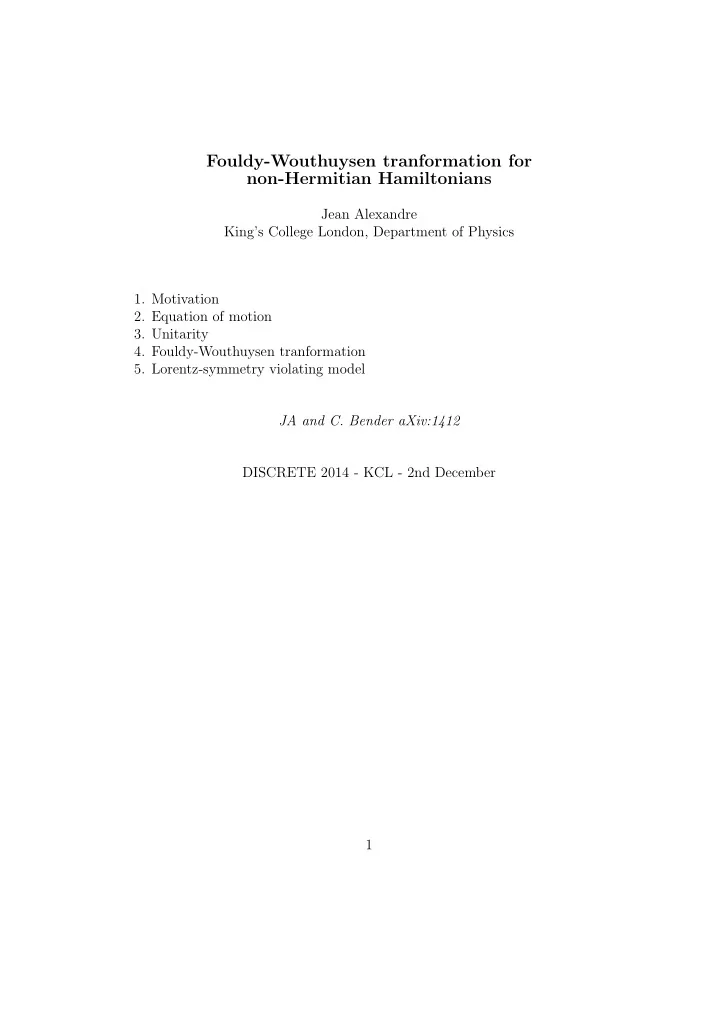

Fouldy-Wouthuysen tranformation for non-Hermitian Hamiltonians Jean Alexandre King’s College London, Department of Physics 1. Motivation 2. Equation of motion 3. Unitarity 4. Fouldy-Wouthuysen tranformation 5. Lorentz-symmetry violating model JA and C. Bender aXiv:1412 DISCRETE 2014 - KCL - 2nd December 1
1 Motivation Parity-violating mass term C. Bender, H. Jones, R. Rivers - 2005 ( i/ ∂ − m − µγ 5 ) L = ψ ψ Non-Hermitian but PT-symmetric Hamiltonian density ( ∇ + m + µγ 5 ) γ · ⃗ H = ψ i⃗ ψ Dispersion relation ω 2 = m 2 + p 2 − µ 2 → real energies for all momenta if m 2 ≥ µ 2 − − → look for a mapping to a Hermitian Hamiltonian 2
Fouldy-Wouthuysen tranformation Original Hamiltonian density and equation of motion H = ψ H ψ − → i∂ 0 ψ = H ψ Mapping (non-unitary) U H U − 1 ≡ ωγ 0 χ ≡ Uψ , and − → Equation of motion for χ i∂ 0 χ = ωγ 0 χ − → Original Hamiltonian mapped onto the Hermitian Hamiltonian density H FW = ωχχ 3
2 Equation of motion Non-Hermitian Lagrangian ) † δS ( δS δψ = 0 not equivalent with = 0 δψ Original derivation of the equation of motion ∫ ∫ d 4 x ψ O ψ = d 4 x ( ϕ a − iχ a )[ γ 0 O ] ab ( ϕ b + iχ b ) S = Variational principle δS δS = 0 , = 0 δϕ a δχ a We find ( 1 δS δϕ + i δS ) = δS γ 0 2 2 δχ δψ − → equivalent with δS/δψ = 0 when ψ and ψ are considered independent. 4
3 Unitarity Naive probability density ψ † ψ not conserved since, for eigen modes ψ † ( t, ⃗ p ) = ψ † (0 , ⃗ p ) exp( i H † t ) exp( − i H t ) ψ (0 , ⃗ p ) ̸ = ψ † (0 , ⃗ p ) ψ ( t, ⃗ p ) ψ (0 , ⃗ p ) − → need for a new definition of current to be conserved Look for j ν = ψγ ν Aψ , with A = a + bγ 5 − → conserved current 1 + µ j ν = ψγ ν ( mγ 5 ) ψ Probability density ρ ≥ 0 for µ 2 ≤ m 2 1 + µ 1 + µ 1 − µ ρ = ψ † ( mγ 5 ) ( ) | ψ R | 2 + ( ) | ψ L | 2 ψ = m m 5
4 Fouldy-Wouthuysen transformation Equation of motion i∂ 0 ψ = γ 0 [ γ + m + µγ 5 ] ⃗ p · ⃗ ψ Look for a mapping χ ≡ Uψ such that m 2 + p 2 − µ 2 γ 0 χ √ i∂ 0 χ = By analogy with the case of the Dirac equation ( ) θ ⃗ p · ⃗ γ + µγ 5 = cos θ + ⃗ p · ⃗ γ + µγ 5 U ≡ exp p 2 − µ 2 sin θ p 2 − µ 2 √ √ − → Necessarily p 2 − µ 2 √ tan(2 θ ) = m 6
Alternative ansatz ( ) γ + µγ 5 γ + µγ 5 θ ′ ⃗ p · ⃗ = cosh θ ′ + ⃗ p · ⃗ U ′ = exp µ 2 − p 2 sinh θ ′ µ 2 − p 2 √ √ Necessarily µ 2 − p 2 √ tanh(2 θ ′ ) = m → equivalent with the previous mapping if θ = iθ ′ − UV regime p 2 ≥ µ 2 swapped with IR regime µ 2 ≥ p 2 Non-singular mappings p 2 → µ 2 U ′ = 1 + ⃗ p · ⃗ γ + µγ 5 p 2 → µ 2 U = lim lim 2 m 7
5 Lorentz-symmetry violating model Lorentz-symmetry violating + non-Hermitian Lagrangian ( i/ ∂ − i/ ) L = ψ b − m ψ CPT even and PT odd Motivated by gravity induced effective Lorentz-symmetry violation (real vev) G. Shore - 2005 b µ ∝ α m 2 ∂ µ R For motion perpendicular to ⃗ b : usual conserved current; dispersion relation ω 2 = m 2 + p 2 − b 2 Fouldy-Wouthuysen transformation ( ) p − i⃗ p 2 − b 2 √ θ ( ⃗ b ) · ⃗ γ U = exp , with tan(2 θ ) = p 2 − b 2 √ m 8
6 Conclusion Consistent non-Hermitian Fermionic Hamiltonian Mapping to a Hermitian Hamiltonian in the parameter space when energies are real Relevance to cancellation of chiral anomaly? Neutino kinematics? 9
Recommend
More recommend